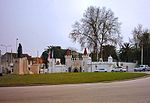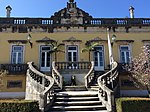Santa Clara e Castelo Viegas
Coimbra geography stubsFreguesias of Coimbra
Santa Clara e Castelo Viegas is a civil parish in the municipality of Coimbra, Portugal. It was formed in 2013 by the merger of the former parishes Santa Clara and Castelo Viegas. The population in 2011 was 11,624, in an area of 17.63 km².
Excerpt from the Wikipedia article Santa Clara e Castelo Viegas (License: CC BY-SA 3.0, Authors).Santa Clara e Castelo Viegas
Rotunda do Lagar, Coimbra Santa Clara (Santa Clara e Castelo Viegas)
Geographical coordinates (GPS) Address Nearby Places Show on map
Geographical coordinates (GPS)
| Latitude | Longitude |
|---|---|
| N 40.2 ° | E -8.44 ° |
Address
Rotunda do Lagar
Rotunda do Lagar
Coimbra, Santa Clara (Santa Clara e Castelo Viegas)
Portugal
Open on Google Maps









